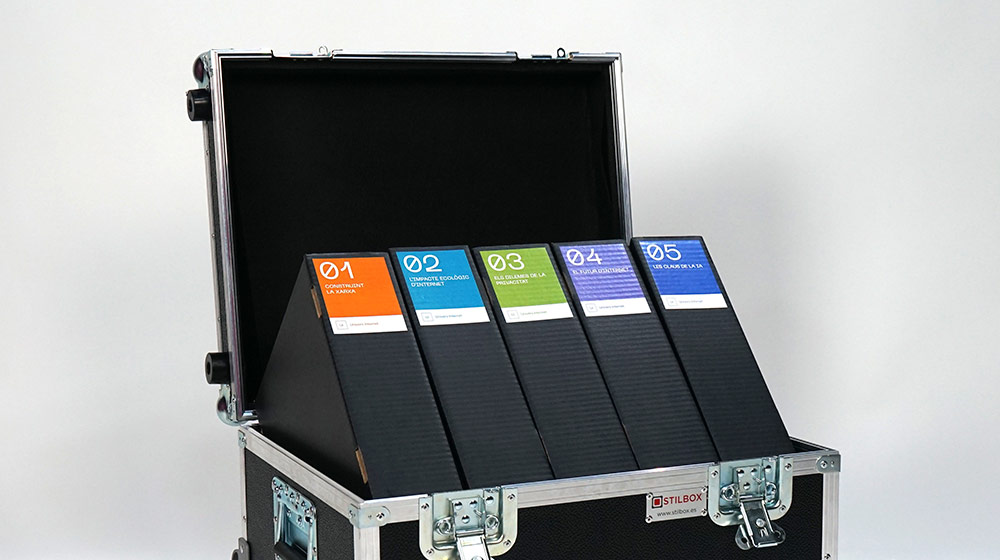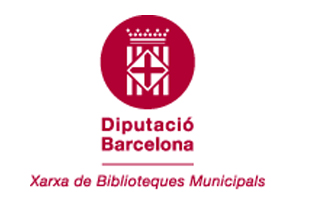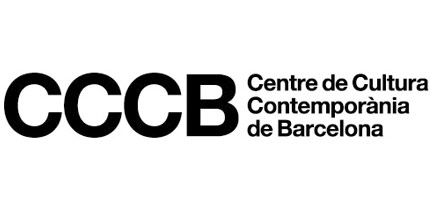Internet Universe
Pedagogical suitcase
Univers Internet is a project that facilitates a critical and creative reflection on the set of technologies linked to the Internet, a phenomenon that is causing an unprecedented transformation in human history.
The Univers Internet teaching bag is made up of five teaching units that allow you to work on different aspects of digital technologies: the infrastructure of the telecommunications network, the ecological impact of the Internet, privacy, the future of the Internet or the artificial intelligence.
Each unit proposes a series of materials and dynamics that allow working on these topics. The workshops are offered for school groups in 15 libraries of the Diputació de Barcelona. You can also download the materials in digital format and do them independently in the classroom.
A project of the Center for Contemporary Culture of Barcelona (CCCB) with the Network of Municipal Libraries of the Barcelona Provincial Council launched in 2017 and reissued in 2024.
Download Univers Internet Pedagogical Suitcase
Unit 01. Building the network
The dynamic consists of weaving a simulated telecommunications network on a plan or a model of a city to get to know the real structure of the Internet. With this methodology we will be able to understand what is needed to be connected to the network and what implications it entails on a social, economic and political scale.
Objectives:
- Explain in your own words what the Internet is, differentiating between the physical infrastructure and the digital services it can offer.
- Identify the basic elements that make up a telecommunications network.
- Discuss the social and economic implications of current telecommunications networks in order to better understand the origin of the digital divide.
This unit and its contents have been developed with the collaboration of Efraín Foglia, member of Guifi.net, Exo.cat and research professor at the Open University of Catalonia.

Unit 02. Ecological impact of the Internet
The dynamics consists of a practical exercise to calculate and visualize the impact of two analog processes (one done analog and the other digital), as well as subsequent decisions such as sending an email (e-mail) in different ways or using devices such as the laptop or the mobile phone, with the aim of becoming aware of this impact and, at the same time, knowing measures to minimize it. The final objective, therefore, is to understand that the Internet, like any other activity or service, generates an impact on the environment.
Objectives:
- Explain why any activity we carry out has an impact on the planet and that the Internet is no exception.
- Understand what the carbon footprint is and what CO2 emissions are.
- Visualize the approximate carbon footprint of everyday actions linked to the use of the Internet.
- Know measures to minimize the ecological impact of the regular use of the Internet.
This unit and its contents have been developed with the collaboration of the inèdit company, within the framework of the CCCB Internet Universe project, and takes as its starting point the articles by Marcus Hurst written for the CCCB Lab blog.

Unit 03. Privacy dilemmas
The dynamic is set up like a board game. The participants, grouped in different teams, will have to answer various questions and situations related to the management of privacy in the digital environment. The aim is to give tools to become aware of what happens to our data and our identity when we use the Internet and discover alternatives to protect ourselves.
Objectives:
- Identify the sensitivity of your personal data.
- Manage your identity and privacy judiciously in the digital environment.
- Explain what the digital trail is.
- Recognize privacy as a fundamental human right.
This unit and its contents were developed with the collaboration of Liliana Arroyo and Óscar Marín (Outliers) and a text by Marilín Gonzalo, and were updated by Marta Delatte in 2024.

Unit 04. The future of the Internet
The dynamic consists of an exercise in speculation about the possible drifts that the future of the Internet may take, relating to access, algorithms and artificial intelligence, social networks, ecology and sustainability, knowledge and privacy. The aim is to reflect on the present and future of the Internet through the design of objects that respond to different ethical, social and environmental challenges. To do this, we propose a dynamic structured in three parts: we will go through the past to understand how we got to where we are, we will analyze the present to understand it better and we will imagine the future because, as Alan Kay says, "the best way to predict the future is inventing it».
Objectives:
- Critically analyze the Internet taking into account various aspects (social, economic, ecological...).
- Question the role of the Internet and new technologies in everyday life.
- Understand the problems of the current way of life, based on the hyperconnectivity of portable devices.
- Create a plausible story about the future and identify possible challenges that it poses to us.
- Design objects that give creative and innovative answers to problems in today's society.
This unit and its contents were initially developed with the collaboration of Carla Boserman, artist, teacher and researcher; and Efraín Foglia, professor and researcher at the Open University of Catalonia, and were updated in 2024 by Núria Nia and Efraín Foglia.

Unit 05. The keys to AI
Dynamics consists of compiling and classifying a set of images (dataset) in order to understand the training process of an artificial intelligence (AI) model. This practice will bring us closer to the social and environmental implications that AI industries currently have.
Objectives:
- Explain how tasks such as tagging images or creating new images are automated.
- Identify the basic elements of the training process of an AI model.
- Discuss the social and environmental implications of the global AI industry.
This unit and its contents have been developed with the collaboration of Estampa.



